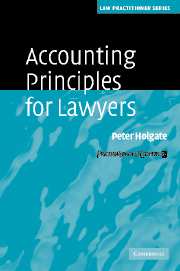Book contents
- Frontmatter
- Contents
- Acknowledgements
- Glossary of terms
- Part I The accounting environment
- Part II Some specifics
- 8 Individual entity accounts and consolidated accounts
- 9 Mergers and acquisitions
- 10 Interaction of accounting with tax
- 11 Assets
- 12 Liabilities
- 13 Leases
- 14 Pensions
- 15 Financial instruments, including capital instruments
- 16 Realised and distributable profits
- 17 Disclosures in published accounts
- 18 Use of financial information in contracts and agreements
- Appendices
- Index
10 - Interaction of accounting with tax
from Part II - Some specifics
Published online by Cambridge University Press: 28 July 2009
- Frontmatter
- Contents
- Acknowledgements
- Glossary of terms
- Part I The accounting environment
- Part II Some specifics
- 8 Individual entity accounts and consolidated accounts
- 9 Mergers and acquisitions
- 10 Interaction of accounting with tax
- 11 Assets
- 12 Liabilities
- 13 Leases
- 14 Pensions
- 15 Financial instruments, including capital instruments
- 16 Realised and distributable profits
- 17 Disclosures in published accounts
- 18 Use of financial information in contracts and agreements
- Appendices
- Index
Summary
Introduction
Company accounts and corporate tax are closely related in a number of ways. First, assessment of corporation tax is based on complex rules of tax law and practice, but the starting point is the pre-tax profit shown in the company's annual statutory accounts. The context here is the entity accounts of individual companies, as tax is levied at the entity level, not at the consolidated level. Second, accounts need to reflect a company's obligations to pay tax. The most obvious example of this is the tax payable in respect of each year. However, in addition, accountants have developed accounting for ‘deferred tax’. Third, there is the question of how the move to IFRS affects tax assessment. These issues are discussed in turn. This chapter seeks to give an introductory guide to accounting aspects of the issues; it is not a guide to tax law or practice.
Accounting profit and its adjustment
Accounting profit – specifically, the profit before tax figure in the profit and loss account – is the starting point for assessment of corporation tax. However, a number of adjustments are made. Examples of adjustments are:
Depreciation of fixed assets that is charged in arriving at profit is added back, as it is not allowable for tax purposes. In its place there is a system of capital allowances, designed to give tax relief for certain types of capital expenditure. The amount and timing of capital allowances is based on tax law, which reflects the government's desire to give companies incentives to invest. Except by coincidence, capital allowances do not equate to accounting depreciation. An example of the relationship between capital allowances and accounting depreciation is shown below, under the heading ‘Deferred tax’.
[…]
- Type
- Chapter
- Information
- Accounting Principles for Lawyers , pp. 110 - 116Publisher: Cambridge University PressPrint publication year: 2006



